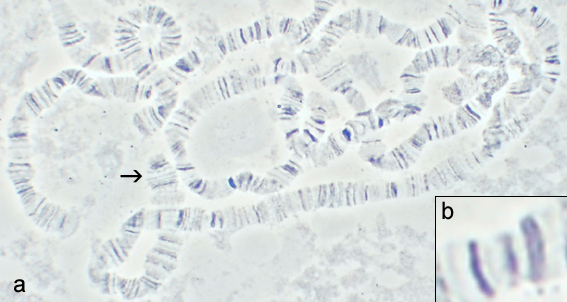This article needs additional citations for verification. (December 2009) |
A chromomere, also known as an idiomere, is one of the serially aligned beads or granules of a eukaryotic chromosome, resulting from local coiling of a continuous DNA thread.[1] Chromomeres are regions of chromatin that have been compacted through localized contraction. In areas of chromatin with the absence of transcription, condensing of DNA and protein complexes will result in the formation of chromomeres.[2] It is visible on a chromosome during the prophase of meiosis and mitosis. Giant banded (Polytene) chromosomes resulting from the replication of the chromosomes and the synapsis of homologs without cell division is a process called endomitosis. These chromosomes consist of more than 1000 copies of the same chromatid that are aligned and produce alternating dark and light bands when stained. The dark bands are the chromomere.
It is unknown when chromomeres first appear on the chromosome. Chromomeres can be observed best when chromosomes are highly condensed.[2] The chromomeres are present during leptotene phase of prophase I during meiosis. During zygotene phase of prophase I, the chromomeres of homologs align with each other to form homologous rough pairing (homology searching). These chromomeres helps provide a unique identity for each homologous pairs. They appear as dense granules during leptotene stage
There are more than 2000 chromomeres on 20 chromosomes of maize.

- ^ Mosby (2016-04-29). Mosby's Medical Dictionary - E-Book. Elsevier Health Sciences. pp. 362–. ISBN 978-0-323-41426-5.
- ^ a b Macgregor, Herbert (September 7, 2012). "Chromomeres revisited". Chromosome Research. 20 (8): 911–924. doi:10.1007/s10577-012-9310-3. hdl:10036/3748. PMID 22956230. Retrieved 2015-09-24.